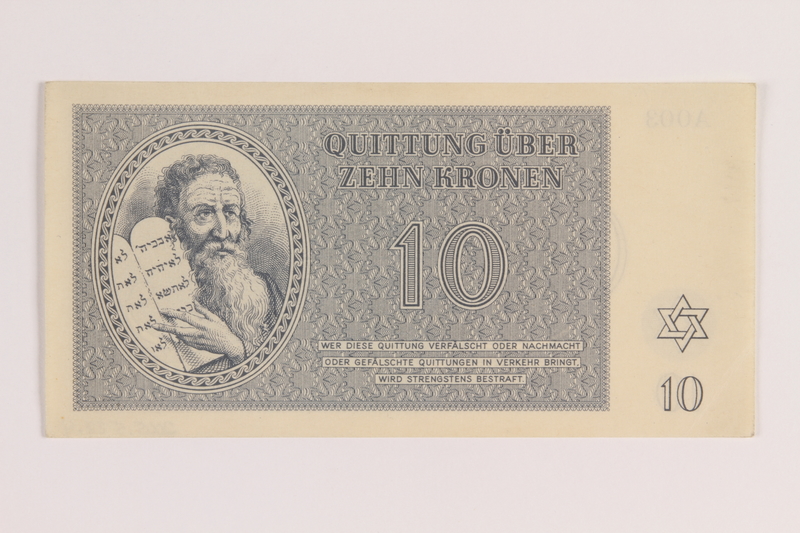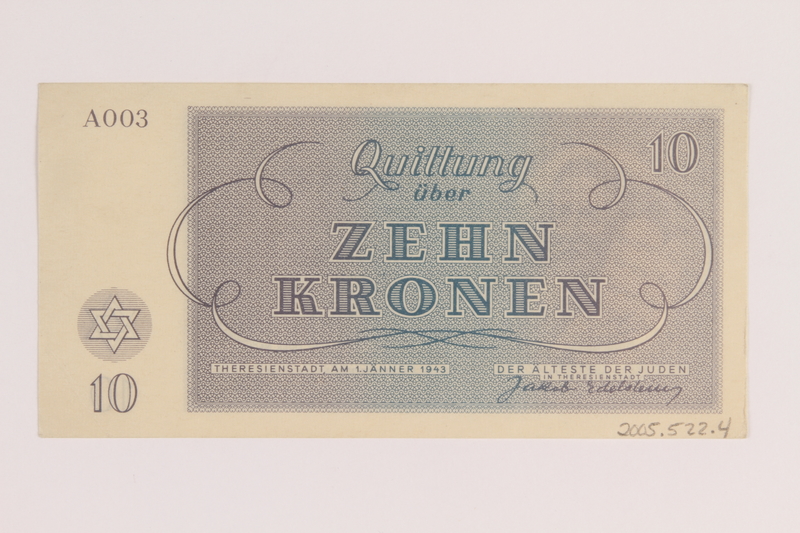Overview
- Brief Narrative
- Scrip receipt for 10 kronen issued to 16 year old Marion Sapir when she was imprisoned in the Theresienstadt labor camp from 1942-1944. Currency was confiscated upon entry and scrip was distributed per a 5-tier rating or received for conscript labor while in camp. Marion found there was nothing to purchase with the notes. In May 1940, Germany occupied the Netherlands, and in July 1941, Marion, her parents, and her 11 year old brother were sent to Westerbork transit camp and deported to Theresienstadt in Czechoslovakia. In 1944, they were transferred to Auschwitz. Her mother was murdered in the gas chambers on arrival. Marion was sent to Oederan labor camp. When that camp was evacuated because of advancing US troops, she was sent back to Theresienstadt where she was liberated in May 1945. Her brother died in a camp shortly after liberation, but her father survived. They were reunited in Amsterdam in September 1945 and immigrated to the United States in 1947.
- Date
-
issue:
1943 January 01
received: 1943-1944
- Geography
-
issue:
Theresienstadt (concentration camp);
Terezin (Ustecky kraj, Czech Republic)
- Credit Line
- United States Holocaust Memorial Museum Collection, Gift of Marion Sapir
- Markings
- face, upper center, blue ink : QUITTUNG ÜBER / ZEHN KRONEN [RECEIPT OF / TEN CROWNS]
face, center, blue ink : 10
face, lower center, smaller text than above, blue ink : WER DIESE QUITTUNG VERFÄLSCHT ODER NACHMACHT / ODER GEFÄLSCHTE QUITTUNGEN IN VERKEHR BRINGT. / WIRD STRENGSTENS BESTRAFT [ANYONE WHO FALSIFIES OR DISTORTS OR FAKES THIS RECEIPT, OR COUNTERFEITS RECEIPT, WILL BE STRICTLY PUNISHED]
face, lower right corner, blue ink: 10
reverse, upper left corner, plate mark, blue ink : A003
reverse, center, blue ink : Quittung / über / ZEHN KRONEN [Receipt / of / TEN CROWNS]
reverse, upper right corner, blue ink : 10
reverse, lower left corner, blue ink : 10
reverse, lower center, blue ink : THERESIENSTADT, AM 1.JANNER 1943 DER ALTESTE DER JUDEN / IN THERESIENSTADT / Jakob Edelstein [THERESIENSTADT, ON 1. JANUARY 1943 THE ELDER OF THE JEWS IN THERESIENSTADT / Jakob Edelstein] - Contributor
-
Subject:
Marion C. Sapir
- Biography
-
Marion Carola Strauss was born on December 20, 1926, to Siegfried (Friedrich), born October 10, 1898, and Marguerite, born September 8, 1902, in Frankfurt am Main, Germany. She had a younger brother, Carl Heinrich, born October 10, 1930. The family was a prosperous, conservative Jewish family, and they lived in a predominantly Christian neighborhood. Her father served in the army during World War I (1914-1918.) After the war, he had a leather import business. They were the only Jewish family in their apartment building; the other residents were members of the Seventh Day Adventist Church next door. The family had a live-in, non-Jewish maid. Her father's brother moved to Palestine in 1932. Marion attended the Philanthropin School, one of the oldest and largest Jewish schools in Frankfurt, where Jews were barred from public schools. In 1933, the Nazi dictatorship under Hitler was established in Germany. A series of anti-Jewish laws made life increasingly difficult. Jewish businesses were boycotted and confiscated. Another uncle left for Great Britain in 1936. Around 1937, Marion's father decided to move the family to Zurich, Switzerland. He was not able to obtain a work permit there, so the family left for Amsterdam, Netherlands.
In May 1940, Germany invaded and occupied the Netherlands. They established policies banning Jews from the civil service and requiring them to register their property and themselves. The Strauss home was confiscated by German officials for housing. The family had to move the next day, with one suitcase each, to an apartment which they shared with another family. Marion had to leave public school because she was Jewish. In February 1941, the Germans deported several hundred Jews to concentration camps. There was a general strike which was brutally dealt with by the Germans. That June, Marion's parents decided to escape to Switzerland, but before that could be arranged, they were arrested and sent to Westerbork transit camp. Marion had nursing papers and so was not arrested, but she did not want to be alone and went with her parents. Siegfried was housed with other WWI veterans and worked with the camp police. Marion, now 15, worked as a nurse in the hospital, caring for sick children. Her brother was a messenger and had his Bar Mitzvah. During a diphtheria outbreak, Marion was quarantined in the hospital. At this time, her family was deported to Theresienstadt ghetto/labor camp in German occupied Czechoslovakia. Nine months later, Marion was deported to Theresienstadt as well. She was shocked by how much weight her mother had lost; she was also covered in welts from bedbugs and lice. At first, she worked in a garden. Later, Marion and her mother worked as forced labor in an armaments factory, splitting the mineral mica into thin shards. Siegfried again worked as a police officer.
Early in 1944, Siefried was transported to Auschwitz concentration camp and, a few months later, 14 year old Carl was scheduled to be sent to Auschwitz. Marion and her mother decided to join him on the transport, even though they were exempt due to their factory work. Upon arrival in Auschwitz, Carl was separated from his mother and sister. Marion's mother was sent directly to the gas chamber. In October 1944, Marion was deported to Oederan, a subcamp of Flossenbürg concentration camp in Germany. Marion was put to work to convert a textile factory into a weapons factory. She carried bricks, then worked the pneumatic drill. Later she was assigned to tend the ovens used for heating the ammunition. Marion was given wire by a Belgium prisoner of war which she used to create combs, forks, toothbrushes, and other personal items for herself and other female prisoners. The woman with whom Marion shared a cot went crazy. The local people were sympathetic to the prisoners, often smuggling them food or other items by such methods as dropping a bag of salt in front the inmates as they walked from the barracks to the factory. One man gave Marion sanitary napkins and toothpaste. In April 1945, as US forces approached the camp, the prisoners were marched or sent by train to Theresienstadt. Shortly after their arrival, the German guards left and the International Red Cross took over administration of the camp. A week later, on May 9, Soviets troops entered the camp and assumed responsibility. Marion soon left, after a Russian soldier attempted to sexually assault her. She walked to the Red Cross camp about 5 miles away. From there, she was sent by truck to a displaced persons camp. During this time, she learned that her brother, Carl, had died in another DP camp shortly after liberation.
After a few weeks, Marion was disinfected and put on a train for Amsterdam, arriving in July 1945. She contacted a former teacher, Mr. Kok, who took her in until she could find suitable housing. She discovered that her father was alive. He had been liberated at Auschwitz in January 1945 by Soviet troops and relocated to Odessa in the Ukraine. They were reunited in Amsterdam in September 1945. Marion started taking classes for certification in physical therapy while she and her father awaited immigration permits for the United States. Siegfried's older brother, who had moved there prior to the war, sponsored their visas and they left Amsterdam in 1947. They sailed on the SS Gripsholm from Sweden in January/February 1947. They settled in Chicago, Illinois. Her father worked in a leather company with his brother. Marion took courses and worked as a physical therapist. Marion married Albert Sapir, who was from Israel, on January 8, 1950. They had six children. Marion's father, now called Friedrich or Fred, died in 1954. Albert passed away in 2005.
Physical Details
- Classification
-
Exchange Media
- Category
-
Money
- Object Type
-
Scrip (aat)
- Physical Description
- Rectangular paper scrip. The front has a graphic design in black and blue ink on a blue background. The front depicts Moses holding 2 stone tablets with the 10 Commandments in Hebrew characters, with a long-fingered hand in fron of the tablets, within a medallion on the left, with the denomination 10 and German text on the right. The right side has a wide offwhite border with the denomination 10 in the lower corner and a 6-pointed Star of David above. The reverse has a blue geometric background with a central purple streak, German text, and a scrollwork line. Below the text is an engraved signature. The denomination 10 is in the upper right corner. The left side has a wide offwhite border with the denomination 10 in the lower corner with a 6-pointed Star of David within a horizontallly lined circle above. The plate letter and number are in the upper left corner.
- Dimensions
- overall: Height: 2.500 inches (6.35 cm) | Width: 5.000 inches (12.7 cm)
- Materials
- overall : paper, ink
Rights & Restrictions
- Conditions on Access
- No restrictions on access
- Conditions on Use
- No restrictions on use
Keywords & Subjects
- Topical Term
- Holocaust survivors--United States--Biography. Holocaust, Jewish (1939-1945)--Netherlands--Personal narratives, Jewish. Jewish families--Netherlands--Biography. World War, 1939-1945--Conscript labor--Personal narratives, Jewish. World War, 1939-1945--Deportations from Netherlands. Women concentration camp inmates--Czech Republic--Terezín (Ustecky kraj)--Personal narratives.
Administrative Notes
- Legal Status
- Permanent Collection
- Provenance
- The Theresienstadt scrip was donated to the United States Holocaust Memorial Museum in 2005 by Marion Sapir.
- Record last modified:
- 2023-01-19 14:22:06
- This page:
- https://collections.ushmm.org/search/catalog/irn523249
Download & Licensing
In-Person Research
- By Appointment
- Request 21 Days in Advance of Visit
- Plan a Research Visit
- Request to See This Object
Contact Us
Also in Marion Sapir collection
The collection consists of a set of Theresienstadt ghetto-labor camp scrip issued to Marion Sapir who was an inmate in the camp during the Holocaust.
Date: 1943 January 01
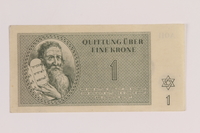
Theresienstadt ghetto-labor camp scrip, 1 krone note issued to a German Jewish inmate
Object
Scrip receipt for 1 krone issued to 16 year old Marion Sapir when she was imprisoned in the Theresienstadt labor camp from 1942-1944. Currency was confiscated upon entry and scrip was distributed per a 5-tier rating or received for conscript labor while in camp. Marion found there was nothing to purchase with the notes. In May 1940, Germany occupied the Netherlands, and in July 1941, Marion, her parents, and her 11 year old brother were sent to Westerbork transit camp and deported to Theresienstadt in Czechoslovakia. In 1944, they were transferred to Auschwitz. Her mother was murdered in the gas chambers on arrival. Marion was sent to Oederan labor camp. When that camp was evacuated because of advancing US troops, she was sent back to Theresienstadt where she was liberated in May 1945. Her brother died in a camp shortly after liberation, but her father survived. They were reunited in Amsterdam in September 1945 and immigrated to the United States in 1947.
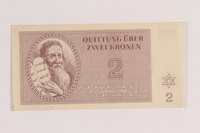
Theresienstadt ghetto-labor camp scrip, 2 kronen note, issued to a German Jewish inmate
Object
Scrip receipt for 2 kronen issued to 16 year old Marion Sapir when she was imprisoned in the Theresienstadt labor camp from 1942-1944. Currency was confiscated upon entry and scrip was distributed per a 5-tier rating based on status or employment or received for conscript labor while in camp. Marion found there was nothing to purchase with the notes. In May 1940, Germany occupied the Netherlands, and in July 1941, Marion, her parents, and her 11 year old brother were sent to Westerbork transit camp and deported to Theresienstadt in Czechoslovakia. In 1944, they were transferred to Auschwitz. Her mother was murdered in the gas chambers on arrival. Marion was sent to Oederan labor camp. When that camp was evacuated because of advancing US troops, she was sent back to Theresienstadt where she was liberated in May 1945. Her brother died in a camp shortly after liberation, but her father survived. They were reunited in Amsterdam in September 1945 and immigrated to the United States in 1947.
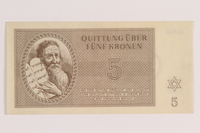
Theresienstadt ghetto-labor camp scrip, 5 kronen note, issued to a German Jewish inmate
Object
Scrip receipt for 5 kronen issued to 16 year old Marion Sapir when she was imprisoned in the Theresienstadt labor camp from 1942-1944. Currency was confiscated upon entry and scrip was distributed per a 5-tier rating or received for conscript labor while in camp. Marion found there was nothing to purchase with the notes. In May 1940, Germany occupied the Netherlands, and in July 1941, Marion, her parents, and her 11 year old brother were sent to Westerbork transit camp and deported to Theresienstadt in Czechoslovakia. In 1944, they were transferred to Auschwitz. Her mother was murdered in the gas chambers on arrival. Marion was sent to Oederan labor camp. When that camp was evacuated because of advancing US troops, she was sent back to Theresienstadt where she was liberated in May 1945. Her brother died in a camp shortly after liberation, but her father survived. They were reunited in Amsterdam in September 1945 and immigrated to the United States in 1947.
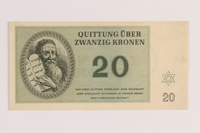
Theresienstadt ghetto-labor camp scrip, 20 kronen note, issued to a German Jewish inmate
Object
Scrip receipt for 20 kronen issued to 16 year old Marion Sapir when she was imprisoned in the Theresienstadt labor camp from 1942-1944. Currency was confiscated upon entry and scrip was distributed per a 5-tier rating or received for conscript labor while in camp. Marion found there was nothing to purchase with the notes. In May 1940, Germany occupied the Netherlands, and in July 1941, Marion, her parents, and her 11 year old brother were sent to Westerbork transit camp and deported to Theresienstadt in Czechoslovakia. In 1944, they were transferred to Auschwitz. Her mother was murdered in the gas chambers on arrival. Marion was sent to Oederan labor camp. When that camp was evacuated because of advancing US troops, she was sent back to Theresienstadt where she was liberated in May 1945. Her brother died in a camp shortly after liberation, but her father survived. They were reunited in Amsterdam in September 1945 and immigrated to the United States in 1947.
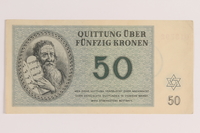
Theresienstadt ghetto-labor camp scrip, 50 kronen note, issued to a German Jewish inmate
Object
Scrip receipt for 50 kronen issued to 16 year old Marion Sapir when she was imprisoned in the Theresienstadt labor camp from 1942-1944. Currency was confiscated upon entry and scrip was distributed per a 5-tier rating or received for conscript labor while in camp. Marion found there was nothing to purchase with the notes. In May 1940, Germany occupied the Netherlands, and in July 1941, Marion, her parents, and her 11 year old brother were sent to Westerbork transit camp and deported to Theresienstadt in Czechoslovakia. In 1944, they were transferred to Auschwitz. Her mother was murdered in the gas chambers on arrival. Marion was sent to Oederan labor camp. When that camp was evacuated because of advancing US troops, she was sent back to Theresienstadt where she was liberated in May 1945. Her brother died in a camp shortly after liberation, but her father survived. They were reunited in Amsterdam in September 1945 and immigrated to the United States in 1947.
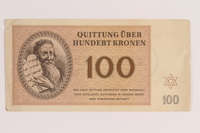
Theresienstadt ghetto-labor camp scrip, 100 kronen note, issued to a German Jewish inmate
Object
Scrip receipt for 100 [hundert] kronen issued to 16 year old Marion Sapir when she was imprisoned in the Theresienstadt labor camp from 1942-1944. Currency was confiscated upon entry and scrip was distributed per a 5-tier rating or received for conscript labor while in camp. Marion found there was nothing to purchase with the notes. In May 1940, Germany occupied the Netherlands, and in July 1941, Marion, her parents, and her 11 year old brother were sent to Westerbork transit camp and deported to Theresienstadt in Czechoslovakia. In 1944, they were transferred to Auschwitz. Her mother was murdered in the gas chambers on arrival. Marion was sent to Oederan labor camp. When that camp was evacuated because of advancing US troops, she was sent back to Theresienstadt where she was liberated in May 1945. Her brother died in a camp shortly after liberation, but her father survived. They were reunited in Amsterdam in September 1945 and immigrated to the United States in 1947.
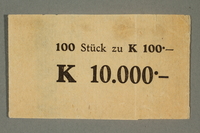
Theresienstadt ghetto-labor camp wrapper for 100 kronen note stack issued to a German Jewish inmate
Object
Money wrapper for a stack of one hundred 100 kronen notes acquired by 16 year old Marion Sapir when she was imprisoned in Theresienstadt ghetto/labor camp from 1942-1944. Currency was confiscated upon entry and scrip was distributed per a 5-tier rating or received for conscript labor while in camp. Marion found there was nothing to purchase with the notes. In May 1940, Germany occupied the Netherlands. In July 1941, Marion, her parents, and her 11 year old brother were sent to Westerbork transit camp and deported to Theresienstadt in Czechoslovakia. In 1944, they were transferred to Auschwitz. Her mother was murdered in the gas chambers on arrival. Marion was sent to Oederan slave labor camp. When that camp was evacuated because of advancing US troops, she was sent back to Theresienstadt where she was liberated in May 1945. Her brother died in a camp shortly after liberation, but her father survived. They were reunited in Amsterdam in September 1945 and immigrated to the United States in 1947.

